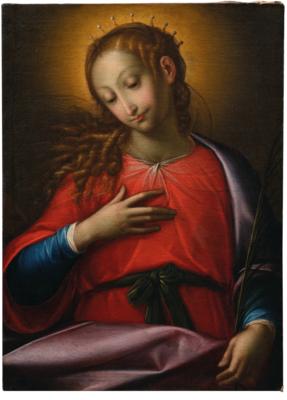Orsola Maddalena Caccia
(Moncalvo 1596–1676)
Saint Catherine of Alexandria,
oil on canvas, 100 x 72 cm, framed
We are grateful to Alberto Cottino for suggesting the attribution of the present painting and for his help in cataloguing this lot.
The present painting shows Saint Catherine of Alexandria as an elegant and pensive young woman, with the palm of martyrdom in her left hand and her wheel at the lower right edge of the scene. The work can be dated to the artist’s maturity and can thus be compared with some of the artist’s best-known paintings, such as the Saint Margaret in the Curtatone Sanctuary (near Mantua), or the altarpiece for the parish church of Castellazzo Bormida, in Piedmont, in which the figure of Saint Agatha is depicted with an almost identical posture and physiognomy. This group of works can be stylistically compared to the Mystical Marriage of Blessed Osanna Andreasi in Carbonarola (Mantua), dated 1648.
The oeuvre of Orsola Maddalena Caccia has only recently been reappraised, following new studies on women artists active during the sixteenth and seventeenth centuries. She was the daughter of the Mannerist painter Guglielmo Caccia, called il Moncalvo (1568–1625), while her maternal grandfather, Ambrogio Oliva, was also an artist. Theodora Caccia, the artist’s birth name before she took Holy Orders, was apprenticed in her father’s studio, assisting him on all of the most important sacred and secular decorative commissions of the period in the regions of Lombardy and Piedmont.
In 1620, Orsola followed four of her sisters into the religious life and entered the Ursuline convent of Bianzé (near Vercelli). In 1625 Guglielmo Caccia financed the building of a new monastery at Moncalvo, next to his own home, and Orsola Maddalena and her sisters moved there shortly before his death. She inherited her father’s studio materials and for the next fifty years directed the workshop she set up within the convent walls, assisted by her sisters, and later, from the 1660s, also by Laura and Angelica Bottero, thereby assuring the economic survival of their small religious community.
Although influenced by her father’s technique, Orsola elaborated a personal style that is attentive to detail, as well as to developments in Lombard and Flemish painting. Despite executing numerous altarpieces, her fame especially rests in her small, refined cabinet paintings, and on her elegant female saints. Her patrons included both the courts of Savoy and the Gonzaga.
Specialist: Mark MacDonnell
 Mark MacDonnell
Mark MacDonnell
+43 1 515 60 403
mark.macdonnell@dorotheum.at
03.05.2023 - 18:00
- Realized price: **
-
EUR 26,000.-
- Estimate:
-
EUR 20,000.- to EUR 30,000.-
Orsola Maddalena Caccia
(Moncalvo 1596–1676)
Saint Catherine of Alexandria,
oil on canvas, 100 x 72 cm, framed
We are grateful to Alberto Cottino for suggesting the attribution of the present painting and for his help in cataloguing this lot.
The present painting shows Saint Catherine of Alexandria as an elegant and pensive young woman, with the palm of martyrdom in her left hand and her wheel at the lower right edge of the scene. The work can be dated to the artist’s maturity and can thus be compared with some of the artist’s best-known paintings, such as the Saint Margaret in the Curtatone Sanctuary (near Mantua), or the altarpiece for the parish church of Castellazzo Bormida, in Piedmont, in which the figure of Saint Agatha is depicted with an almost identical posture and physiognomy. This group of works can be stylistically compared to the Mystical Marriage of Blessed Osanna Andreasi in Carbonarola (Mantua), dated 1648.
The oeuvre of Orsola Maddalena Caccia has only recently been reappraised, following new studies on women artists active during the sixteenth and seventeenth centuries. She was the daughter of the Mannerist painter Guglielmo Caccia, called il Moncalvo (1568–1625), while her maternal grandfather, Ambrogio Oliva, was also an artist. Theodora Caccia, the artist’s birth name before she took Holy Orders, was apprenticed in her father’s studio, assisting him on all of the most important sacred and secular decorative commissions of the period in the regions of Lombardy and Piedmont.
In 1620, Orsola followed four of her sisters into the religious life and entered the Ursuline convent of Bianzé (near Vercelli). In 1625 Guglielmo Caccia financed the building of a new monastery at Moncalvo, next to his own home, and Orsola Maddalena and her sisters moved there shortly before his death. She inherited her father’s studio materials and for the next fifty years directed the workshop she set up within the convent walls, assisted by her sisters, and later, from the 1660s, also by Laura and Angelica Bottero, thereby assuring the economic survival of their small religious community.
Although influenced by her father’s technique, Orsola elaborated a personal style that is attentive to detail, as well as to developments in Lombard and Flemish painting. Despite executing numerous altarpieces, her fame especially rests in her small, refined cabinet paintings, and on her elegant female saints. Her patrons included both the courts of Savoy and the Gonzaga.
Specialist: Mark MacDonnell
 Mark MacDonnell
Mark MacDonnell
+43 1 515 60 403
mark.macdonnell@dorotheum.at
|
Buyers hotline
Mon.-Fri.: 10.00am - 5.00pm
old.masters@dorotheum.at +43 1 515 60 403 |
| Auction: | Old Master Paintings |
| Auction type: | Saleroom auction with Live Bidding |
| Date: | 03.05.2023 - 18:00 |
| Location: | Vienna | Palais Dorotheum |
| Exhibition: | 22.04. - 03.05.2023 |
** Purchase price incl. charges and taxes
It is not possible to turn in online buying orders anymore. The auction is in preparation or has been executed already.

